

 |
 |
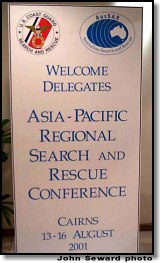 On August 13 through 16, 2001, the Asia-Pacific Regional Search and Rescue Conference was held in Cairns, Australia, sponsored by the United States Coast Guard and AusSAR (Australia's search and rescue service). This reporter attended as a guest of the sponsors and was honored to be invited to give one of the conference presentations, "Life Rafts: The Survivor's Perspective."
On August 13 through 16, 2001, the Asia-Pacific Regional Search and Rescue Conference was held in Cairns, Australia, sponsored by the United States Coast Guard and AusSAR (Australia's search and rescue service). This reporter attended as a guest of the sponsors and was honored to be invited to give one of the conference presentations, "Life Rafts: The Survivor's Perspective."
The focus of the conference was on improving and expanding international cooperation among the many SAR services that operate in this region of the world, typified by vast distances, limited and widely varying SAR resources and overlapping areas of responsibility. Attending were over 50 representatives from 15 national SAR services ranging from the Solomon Islands to Vietnam and China (see complete list below). Put together on relatively short notice due to a combination of circumstances, numerous other nations expressed interest, but were unable to attend due to funding limitations in current budgets. Based on the success of the meeting, the conference is expected to double in size for the next iteration as these nations have time to budget for the expenditures.
For the most part, attendees were upper level SAR managers and Rescue Coordination Center managers and watchstanders, those who develop national SAR policies and who implement the policies and plan actual searches. There was a small exhibition space for industries that support SAR services; another area I expect will be expanded next time around.
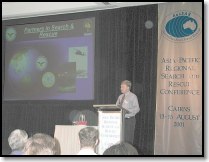 Alan Liotta, United States Deputy Assistant Secretary for Defense, set the tone for the conference in his keynote address where he spoke of how the universally accepted humanitarian mission of saving lives can serve to bridge the often significant differences among neighboring nations. This over-reaching and unifying goal was very much in evidence as attendees worked together at the conference towards the common goal of improving SAR response in the immense Asia Pacific region.
Alan Liotta, United States Deputy Assistant Secretary for Defense, set the tone for the conference in his keynote address where he spoke of how the universally accepted humanitarian mission of saving lives can serve to bridge the often significant differences among neighboring nations. This over-reaching and unifying goal was very much in evidence as attendees worked together at the conference towards the common goal of improving SAR response in the immense Asia Pacific region.
The conference chairman, Captain Ray Miller, the new USCG Chief of Search and Rescue, did a super job of keeping the conference on track, not a easy task given the tightly packed schedule coupled with occasional language difficulties and a few over-exuberant presenters. Miller set a casual tone for the meetings that served to encourage a relaxed and interactive atmosphere conducive to give and take among the participants.
The conference started off with presentations by most of the SAR services present on the current state of SAR in their respective areas of responsibilities. This only served to amplify how limited SAR resources are in the region. There are few dedicated assets, such as we in the North America take for granted; most search and rescue is performed via civil units pressed into SAR service, civilian boating and commercial shipping diversions, or military assets, themselves often limited, used when available.
The nations in the area have organized to do a lot with their limited resources and it is impressive how they have evolved their SAR services to accommodate their particular situations. The good news is that they all take SAR seriously and are prepared to come to your rescue if necessary. Communications are key and often a serious problem for local populations without significant communications infrastructure.
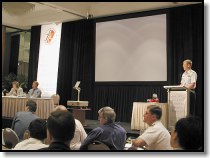 Bottom line message from the conference for those traveling in the region; a 406 MHz emergency beacon is critical, along with portable, waterproof VHF radio(s) ideally capable of communication on both maritime and aviation distress frequencies. Don't leave home without 'em!
Bottom line message from the conference for those traveling in the region; a 406 MHz emergency beacon is critical, along with portable, waterproof VHF radio(s) ideally capable of communication on both maritime and aviation distress frequencies. Don't leave home without 'em!
Beyond areas close in to the coast of Australia or Asia, your most likely rescue is going be via boat. While there are capable long-range search aircraft in the region, they cannot pick you up and not all have drop capability. This also means you had best be prepared for a somewhat extended stay, compared to what you might expect around North America or the Caribbean. For anyone venturing across open stretches of the Pacific or far south in the Pacific, rescue can be a very long ways off, so prepare accordingly.
There were three workshops held during the conference, allowing participants to interact in cooperative problem-solving sessions. The results spoke well for the commitment the participants had to solving existing problems and to standardizing policies and procedures as much as is possible. This all helps with interoperability and communication issues between the nations. The recently introduced IAMSAR (International Aeronautical and Maritime Search And Rescue) Manual promulgated by IMO and ICAO will eventually form the basis for much of this, but not every nation has yet adopted and adapted the manual. It appeared that most, if not all, conference attendees left with some degree of commitment to see the IAMSAR Manual incorporated into their national SAR policy, which will go a long ways towards solving interoperability and communications problems.
Another issue that came up often with regards to communications was the need for better training of non-native English speaking SAR personnel in English, the defacto international language of search and rescue. Even among the participants, whose English skills varied, but which for the most were generally above average for those for whom English was not their native tongue, communications during the conference were somewhat confused at times. Typically in such cases as occurred, questions and answers initially had little relation to one another until a misunderstanding was resolved, and sometimes it never was. This only served to emphasize how critical this is when communicating between RCCs and when multi-national SAR forces are prosecuting a search or rescue, as is often the case in the region.
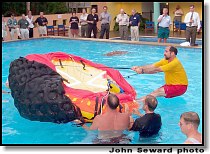 Extracurricular related activities included a demonstration of Switlik life rafts in the pool during one evening's pool side cocktail party, Switlik demonstrated two search and rescue life rafts, a 20-person SAR-20 (sort of a SAR-6 MkII on steroids in aircraft weight fabric, designed originally for use on C-130 Hercules) and an 8-person POD-8 (as recently ordered by the USCG), with Capt. Miller, Commander Steward and myself among those posing as survivors with Stanley Switlik. The relatively cold water, with a light breeze to hasten along potential hypothermia, certainly served as another object lesson on the importance of an effective canopy. Even without an insulated floor in the POD-8 demo raft, closing up the canopy resulted in a nearly immediate increase in warmth among those of us in the raft.
Extracurricular related activities included a demonstration of Switlik life rafts in the pool during one evening's pool side cocktail party, Switlik demonstrated two search and rescue life rafts, a 20-person SAR-20 (sort of a SAR-6 MkII on steroids in aircraft weight fabric, designed originally for use on C-130 Hercules) and an 8-person POD-8 (as recently ordered by the USCG), with Capt. Miller, Commander Steward and myself among those posing as survivors with Stanley Switlik. The relatively cold water, with a light breeze to hasten along potential hypothermia, certainly served as another object lesson on the importance of an effective canopy. Even without an insulated floor in the POD-8 demo raft, closing up the canopy resulted in a nearly immediate increase in warmth among those of us in the raft.
We were also treated to a SAR demo out in the waters off the Great Barrier Reef with fixed wing civil aircraft drops of both a life raft and supplies via the PADS system, providing an impressive display of accuracy. Also demonstrated were AusSAR's unique "heliboxes", used to deliver up to 7 Kg of supplies from an aircraft, whose simplicity, low cost and effectiveness impressed everyone in the group. After deployment out the aircraft door, the box is delivered to a soft landing as the fixed cardboard "rotors" at the top autorotate the box to slow the descent.
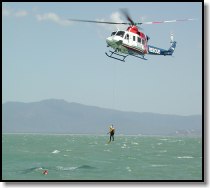 Queensland Rescue, one of the civil companies contracted to AusSAR, also demonstrated their Bell 412 helicopter performing a number of winches, first directly from the Switlik SAR (original style) life raft deployed in the PADS demo, which also served to demonstrate the stability of their toroidal ballast, then from the water. Included was a hoist designed to accommodate a hypothermic survivor where two strops are used, one under the arms as usual, and another under the knees. This keeps the patient more or less level during the hoist, preventing the fatalities that have commonly resulted from a normal underarm-only hoist of a hypothermic survivor. (A basket, such as is generally deployed by the USCG, is rarely employed elsewhere in the world.)
Queensland Rescue, one of the civil companies contracted to AusSAR, also demonstrated their Bell 412 helicopter performing a number of winches, first directly from the Switlik SAR (original style) life raft deployed in the PADS demo, which also served to demonstrate the stability of their toroidal ballast, then from the water. Included was a hoist designed to accommodate a hypothermic survivor where two strops are used, one under the arms as usual, and another under the knees. This keeps the patient more or less level during the hoist, preventing the fatalities that have commonly resulted from a normal underarm-only hoist of a hypothermic survivor. (A basket, such as is generally deployed by the USCG, is rarely employed elsewhere in the world.)
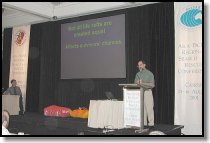 My own presentation seemed to go over quite well. After the PowerPoint aided presentation, which featured video clips from our Life Rafts in the Desert™ testing exercise, I asked members of the conference to come on stage and deploy three life rafts, a Switlik Parachute Company 6-person Search and Rescue Mk II (SAR-6 Mk-II marine version), a Survival Products FAA approved 6-person Type I, and a Winslow LifeRaft Company FAA/CAA/DGAC approved 6-person FAAV Super-Light Ultima. (Thanks to Switlik and Winslow for their cooperation in supplying their demo rafts.)
My own presentation seemed to go over quite well. After the PowerPoint aided presentation, which featured video clips from our Life Rafts in the Desert™ testing exercise, I asked members of the conference to come on stage and deploy three life rafts, a Switlik Parachute Company 6-person Search and Rescue Mk II (SAR-6 Mk-II marine version), a Survival Products FAA approved 6-person Type I, and a Winslow LifeRaft Company FAA/CAA/DGAC approved 6-person FAAV Super-Light Ultima. (Thanks to Switlik and Winslow for their cooperation in supplying their demo rafts.)
From the audience reaction, including a lengthy Q&A session after deploying the rafts, I conclude that my presentation was an eye-opening experience with regards the capabilities, or lack thereof, of many life rafts in common use.
Richard Switlik, president of Switlik, pigeonholed me after my presentation to discuss a variety of issues and concerns he had with the results of our life raft tests. It's always enlightening to receive frank comments directly from the manufacturer.
While much of our discussion was confidential, Richard did advise me that as a result of my continued harping on the subject (paraphrasing his words and intent, I wasn't taking notes) of the critical need for a swivel in the attachment line of life raft drogues (sea anchors), that Switlik would be installing swivels on all their drogues going forward. Stanley Switlik told me that consumers can expect this upgrade to enter production "in the near future," as soon as they settle some minor engineering issues.
The addition of a swivel to all their drogues represents a significant improvement in the ultimate life saving capability of Switlik's recreational life raft line, for which they should be complimented.
Much of the gear displayed by vendors was old news, but there were two interesting new products on display, both emergency beacons.
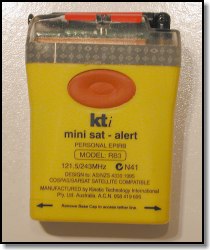 Kinetic Technology International Pty Ltd was displaying it's and RB3S model 121.5 and 243 MHz "mini SAT-ALERT" personal beacons. At only $300 AUSD (about $150 USD), the pocket size beacon would serve as an economical means of alerting, particularly where a preferred 406 MHz beacon is unavailable (as is the case currently in the U.S.) or simply too large or bulky. (click image for multiple views)
Kinetic Technology International Pty Ltd was displaying it's and RB3S model 121.5 and 243 MHz "mini SAT-ALERT" personal beacons. At only $300 AUSD (about $150 USD), the pocket size beacon would serve as an economical means of alerting, particularly where a preferred 406 MHz beacon is unavailable (as is the case currently in the U.S.) or simply too large or bulky. (click image for multiple views)
Compared to similar sized beacons over here, such as ACR's MiniB300 EPIRB, it has a telescoping and folding antenna that makes for a much more compact package, truly pocket size at 4.3 x 3.1 x 1.5 inches (11 x 8 x 3.8 cm) and 7.6 oz. (215 grams). The plastic case has no sharp edges and it is self-buoyant (but does not float upright). It comes with a carrying case, belt loop and neck strap.
The antenna can be set to vertical, no matter how the case is aligned, a nice feature that can make it easier to use in a variety of circumstances. There is a tether in a bottom compartment, as well as a rudimentary signal mirror (applied reflective material, not one you should depend upon). I'd prefer some means to attach a lanyard to the exterior. You don't want to have to be doing that after the fact in many survival circumstances
Battery life (a pair of 3-volt C-cell size lithiums that can be exchanged) is given at four days for the standard beacon, 3.5 days for the beacon with "strobe." That strobe is actually a pair of white LEDs that flash, not a bad idea, but hardly as bright as a strobe, which themselves aren't as effective as many believe. It comes with a five year limited warranty. KTI told us they were looking into getting FCC approval and U.S. distribution.
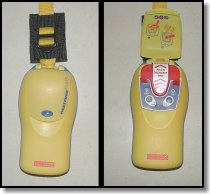 Pains Wessex Safety Systems (who distribute a branded version of the above KTI beacon to the marine market in Australia) were showing off their 406 MHz "Fastfind" and "Fastfind Plus" PLBs (personal locator beacons) that should be available early this fall, except of course in the U.S. where our Air Force, which professes to be committed to "save lives and aid the injured" (link may not function due to current events), continues to oppose approval of PLBs. The only difference between the two units is that the Plus unit incorporates a GPS receiver to transmit actual position. (click image for multiple views)
Pains Wessex Safety Systems (who distribute a branded version of the above KTI beacon to the marine market in Australia) were showing off their 406 MHz "Fastfind" and "Fastfind Plus" PLBs (personal locator beacons) that should be available early this fall, except of course in the U.S. where our Air Force, which professes to be committed to "save lives and aid the injured" (link may not function due to current events), continues to oppose approval of PLBs. The only difference between the two units is that the Plus unit incorporates a GPS receiver to transmit actual position. (click image for multiple views)
The innards are based on their "SOS Precision 406" series of EPIRBs. The nice, ergonomic looking case incorporates a cover over the controls buttons and antenna and has no sharp or square edges, which is a nice feature. You flip open the cover to access the buttons and to deploy the fixed blade style antenna.
Two batteries are offered, one provides rated life to -20 C, the other much larger and heavier one, to -40 C. This is an interesting approach to the problem of weight in these units and I'm glad to see the approving authorities are accommodating such innovation.
At 5.7 x 3 x 1.9 or 2.4 inches (14.6 x 7.8 x 4.8 or 6 cm) depending upon battery, it is fairly compact and with the smaller battery would comfortably fit in a jacket pocket or in a pouch at your waist. With the -20 battery it is quite light, only 9 oz (260 grams). Even with the -40 battery is less than a pound, 14 oz. (400 grams). Prices were quoted at $1500 and $2000 AUSD (about $750 and $1000 USD)
These Fastfind PLBs raise the bar in the 406 MHz PLB wars, a sign that we can expect to see continued fairly rapid innovation and improvements in the emergency beacon market, despite continued consolidation of manufacturers in this market. It's become somewhat like computers, whatever you buy today will be outdated, in terms of features, weight or size, in a few months. Ultimately, this will be great for consumers, though it doesn't make choosing a beacon any easier.
Much of the credit for a well-executed conference must go to the friendly people from AusSAR who did a magnificent job with little time to prepare, along with the Coast Guard's Lieutenant Commander Paul Steward who includes responsibility for International SAR Conferences among his many duties. This was one of the best-organized and productive conferences I've been to, with nary a misstep, for which they deserve plenty of credit.
|
| SELECT AND USE OUTDOORS AND SURVIVAL EQUIPMENT, SUPPLIES AND TECHNIQUES AT YOUR OWN RISK. Please review the full WARNING & DISCLAIMER about information on this site. |
Publisher and Editor: Doug Ritter
Email: Doug Ritter
URL:
http://www.equipped.org/aprsarconf_01.htm
First Published: September 14, 2001
![]()
Email to: [email protected]
|
© 2001 Douglas S. Ritter & Equipped To Survive Foundation, Inc. All rights reserved. Check our Copyright Information page for additional information. |
Read the ETS Privacy Policy |